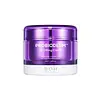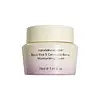What's inside
What's inside
 Key Ingredients
Key Ingredients

 Benefits
Benefits

 Concerns
Concerns

 Ingredients Side-by-side
Ingredients Side-by-side

Water
Skin ConditioningLactobacillus Ferment Lysate
Skin ConditioningGlycerin
HumectantDipropylene Glycol
HumectantCaprylic/Capric Triglyceride
MaskingCetearyl Alcohol
EmollientLimnanthes Alba Seed Oil
Skin ConditioningGlycereth-26
HumectantVinyldimethicone
Hydrogenated Poly(C6-14 Olefin)
EmollientHydrogenated Polydecene
EmollientPolyglyceryl-3 Methylglucose Distearate
EmulsifyingGlyceryl Stearate
EmollientBetaine
HumectantPolyglycerin-3
Humectant1,2-Hexanediol
Skin ConditioningCetearyl Olivate
Pentylene Glycol
Skin ConditioningPhytosteryl/Behenyl/Octyldodecyl Lauroyl Glutamate
Skin ConditioningLactobacillus Ferment
Skin ConditioningFructooligosaccharides
HumectantFructan
Skin ConditioningInulin
Skin ConditioningPanthenol
Skin ConditioningBeta-Glucan
Skin ConditioningAdenosine
Skin ConditioningSaponins
CleansingSoluble Proteoglycan
Skin ConditioningNonapeptide-1
Skin ConditioningAcetyl Tetrapeptide-9
Skin ConditioningAcetyl Tetrapeptide-5
HumectantAcetyl Hexapeptide-1
Skin ConditioningAcetyl Hexapeptide-8
HumectantPalmitoyl Tripeptide-8
Skin ConditioningDipeptide Diaminobutyroyl Benzylamide Diacetate
Skin ConditioningCopper Tripeptide-1
Skin ConditioningTripeptide-1
Skin ConditioningPalmitoyl Tetrapeptide-7
Skin ConditioningPalmitoyl Tripeptide-1
Skin ConditioningPalmitoyl Tripeptide-5
Skin ConditioningPalmitoyl Pentapeptide-4
Skin ConditioningPalmitoyl Hexapeptide-12
Skin ConditioningPentapeptide-3
Skin ConditioningHexapeptide-9
Skin ConditioningOligopeptide-2
Skin ConditioningMalt Extract
Skin ProtectingDioscorea Japonica Root Extract
Skin ConditioningElaeis Guineensis Oil
EmollientBehenyl Alcohol
EmollientSorbitan Olivate
EmulsifyingButyrospermum Parkii Butter
Skin ConditioningDipentaerythrityl Hexahydroxystearate/Hexastearate/Hexarosinate
Skin ConditioningHydrogenated Rapeseed Oil
EmollientHydroxyacetophenone
AntioxidantSodium Polyacrylate
AbsorbentHydrolyzed Jojoba Esters
Skin ConditioningPEG-100 Stearate
Ethylhexylglycerin
Skin ConditioningAcrylates/C10-30 Alkyl Acrylate Crosspolymer
Emulsion StabilisingXanthan Gum
EmulsifyingTromethamine
BufferingButylene Glycol
HumectantMaltodextrin
AbsorbentCyanocobalamin
Skin ConditioningCetyl Ethylhexanoate
EmollientPropanediol
SolventCetearyl Glucoside
EmulsifyingAlgin
MaskingSodium Stearoyl Glutamate
CleansingTocopherol
AntioxidantBiosaccharide Gum-4
Skin ConditioningMineral Salts
Skin ConditioningHydrolyzed Corn Starch
HumectantSodium Phosphate
BufferingCaprylyl Glycol
EmollientSucrose
HumectantDextran
Disodium Phosphate
BufferingParfum
MaskingWater, Lactobacillus Ferment Lysate, Glycerin, Dipropylene Glycol, Caprylic/Capric Triglyceride, Cetearyl Alcohol, Limnanthes Alba Seed Oil, Glycereth-26, Vinyldimethicone, Hydrogenated Poly(C6-14 Olefin), Hydrogenated Polydecene, Polyglyceryl-3 Methylglucose Distearate, Glyceryl Stearate, Betaine, Polyglycerin-3, 1,2-Hexanediol, Cetearyl Olivate, Pentylene Glycol, Phytosteryl/Behenyl/Octyldodecyl Lauroyl Glutamate, Lactobacillus Ferment, Fructooligosaccharides, Fructan, Inulin, Panthenol, Beta-Glucan, Adenosine, Saponins, Soluble Proteoglycan, Nonapeptide-1, Acetyl Tetrapeptide-9, Acetyl Tetrapeptide-5, Acetyl Hexapeptide-1, Acetyl Hexapeptide-8, Palmitoyl Tripeptide-8, Dipeptide Diaminobutyroyl Benzylamide Diacetate, Copper Tripeptide-1, Tripeptide-1, Palmitoyl Tetrapeptide-7, Palmitoyl Tripeptide-1, Palmitoyl Tripeptide-5, Palmitoyl Pentapeptide-4, Palmitoyl Hexapeptide-12, Pentapeptide-3, Hexapeptide-9, Oligopeptide-2, Malt Extract, Dioscorea Japonica Root Extract, Elaeis Guineensis Oil, Behenyl Alcohol, Sorbitan Olivate, Butyrospermum Parkii Butter, Dipentaerythrityl Hexahydroxystearate/Hexastearate/Hexarosinate, Hydrogenated Rapeseed Oil, Hydroxyacetophenone, Sodium Polyacrylate, Hydrolyzed Jojoba Esters, PEG-100 Stearate, Ethylhexylglycerin, Acrylates/C10-30 Alkyl Acrylate Crosspolymer, Xanthan Gum, Tromethamine, Butylene Glycol, Maltodextrin, Cyanocobalamin, Cetyl Ethylhexanoate, Propanediol, Cetearyl Glucoside, Algin, Sodium Stearoyl Glutamate, Tocopherol, Biosaccharide Gum-4, Mineral Salts, Hydrolyzed Corn Starch, Sodium Phosphate, Caprylyl Glycol, Sucrose, Dextran, Disodium Phosphate, Parfum
Water
Skin ConditioningGlycerin
HumectantButylene Glycol
HumectantCaprylic/Capric Triglyceride
MaskingDicaprylyl Carbonate
Emollient1,2-Hexanediol
Skin ConditioningCeramide NP
Skin ConditioningSodium Acrylate/Sodium Acryloyldimethyl Taurate Copolymer
Emulsion StabilisingCetearyl Olivate
Polyisobutene
Hydrogenated Lecithin
EmulsifyingPolyglyceryl-3 Distearate
EmulsifyingSorbitan Olivate
EmulsifyingCetearyl Alcohol
EmollientCarbomer
Emulsion StabilisingArginine
MaskingMannitol
HumectantStearic Acid
CleansingArachidyl Alcohol
EmollientAllantoin
Skin ConditioningXanthan Gum
EmulsifyingBehenyl Alcohol
EmollientEthylhexylglycerin
Skin ConditioningSorbitan Oleate
EmulsifyingCaprylyl/Capryl Glucoside
CleansingArachidyl Glucoside
EmulsifyingGlyceryl Stearate Citrate
EmollientHydrogenated Olive Oil Decyl Esters
Emulsion StabilisingOryza Sativa Extract
AbsorbentPhyllostachys Pubescens Shoot Bark Extract
Skin ConditioningDisodium EDTA
Aspergillus Ferment
Skin ConditioningHydrogenated Olive Oil Stearyl Esters
Emulsion StabilisingCeramide Ns
Skin ConditioningPhytosphingosine
Skin ConditioningCholesterol
EmollientOryza Sativa Lees Extract
Skin ConditioningPanax Ginseng Root Extract
EmollientTocopherol
AntioxidantCeramide As
Skin ConditioningCeramide AP
Skin ConditioningCyclodextrin
AbsorbentCeramide EOP
Skin ConditioningWater, Glycerin, Butylene Glycol, Caprylic/Capric Triglyceride, Dicaprylyl Carbonate, 1,2-Hexanediol, Ceramide NP, Sodium Acrylate/Sodium Acryloyldimethyl Taurate Copolymer, Cetearyl Olivate, Polyisobutene, Hydrogenated Lecithin, Polyglyceryl-3 Distearate, Sorbitan Olivate, Cetearyl Alcohol, Carbomer, Arginine, Mannitol, Stearic Acid, Arachidyl Alcohol, Allantoin, Xanthan Gum, Behenyl Alcohol, Ethylhexylglycerin, Sorbitan Oleate, Caprylyl/Capryl Glucoside, Arachidyl Glucoside, Glyceryl Stearate Citrate, Hydrogenated Olive Oil Decyl Esters, Oryza Sativa Extract, Phyllostachys Pubescens Shoot Bark Extract, Disodium EDTA, Aspergillus Ferment, Hydrogenated Olive Oil Stearyl Esters, Ceramide Ns, Phytosphingosine, Cholesterol, Oryza Sativa Lees Extract, Panax Ginseng Root Extract, Tocopherol, Ceramide As, Ceramide AP, Cyclodextrin, Ceramide EOP
 Reviews
Reviews

Ingredients Explained
These ingredients are found in both products.
Ingredients higher up in an ingredient list are typically present in a larger amount.
1,2-Hexanediol is a synthetic liquid and another multi-functional powerhouse.
It is a:
- Humectant, drawing moisture into the skin
- Emollient, helping to soften skin
- Solvent, dispersing and stabilizing formulas
- Preservative booster, enhancing the antimicrobial activity of other preservatives
Behenyl Alcohol is a type of fatty alcohol (these are different from the drying, solvent alcohols).
Fatty Alcohols have hydrating properties and are most often used as an emollient or to thicken a product. They are usually derived from natural fats and oils; behenyl alcohol is derived from the fats of vegetable oils.
Emollients help keep your skin soft and hydrated by creating a film that traps moisture in.
In 2000, Behenyl Alcohol was approved by the US as medicine to reduce the duration of cold sores.
Learn more about Behenyl AlcoholButylene Glycol (or BG) is used within cosmetic products for a few different reasons:
Overall, Butylene Glycol is a safe and well-rounded ingredient that works well with other ingredients.
Though this ingredient works well with most skin types, some people with sensitive skin may experience a reaction such as allergic rashes, closed comedones, or itchiness.
Learn more about Butylene GlycolThis ingredient is an emollient, solvent, and texture enhancer. It is considered a skin-softener by helping the skin prevent moisture loss.
It helps thicken a product's formula and makes it easier to spread by dissolving clumping compounds.
Caprylic Triglyceride is made by combining glycerin with coconut oil, forming a clear liquid.
While there is an assumption Caprylic Triglyceride can clog pores due to it being derived from coconut oil, there is no research supporting this.
Learn more about Caprylic/Capric TriglycerideCetearyl alcohol is a mixture of two fatty alcohols: cetyl alcohol and stearyl alcohol. It is mainly used as an emulsifier. Emulsifiers help prevent the separation of oils and products. Due to its composition, it can also be used to thicken a product or help create foam.
Cetearyl alcohol is an emollient. Emollients help soothe and hydrate the skin by trapping moisture.
Studies show Cetearyl alcohol is non-toxic and non-irritating. The FDA allows products labeled "alcohol-free" to have fatty alcohols.
This ingredient is usually derived from plant oils such as palm, vegetable, or coconut oils. There is debate on whether this ingredient will cause acne.
Due to the fatty acid base, this ingredient may not be Malassezia folliculitis safe.
Learn more about Cetearyl AlcoholCetearyl Olivate is an emulsifier and texture enhancer. It is derived from the fatty acids of olive oil and Cetearyl alcohol, and is biodegradable.
As an emulsifier, it is used to prevent oils and waters from separating. It can also
Manufacturers use the name Olivem 1000. This ingredient has been found to preserve the natural microbiome of skin. Having a healthy microbiome helps keep our skin healthy and protects against harmful bacteria. This ingredient is grouped with Sorbitan Olivate under the name Olivem 1000.
Learn more about Cetearyl OlivateEthylhexylglycerin (we can't pronounce this either) is commonly used as a preservative and skin softener. It is derived from glyceryl.
You might see Ethylhexylglycerin often paired with other preservatives such as phenoxyethanol. Ethylhexylglycerin has been found to increase the effectiveness of these other preservatives.
Glycerin is already naturally found in your skin. It helps moisturize and protect your skin.
A study from 2016 found glycerin to be more effective as a humectant than AHAs and hyaluronic acid.
As a humectant, it helps the skin stay hydrated by pulling moisture to your skin. The low molecular weight of glycerin allows it to pull moisture into the deeper layers of your skin.
Hydrated skin improves your skin barrier; Your skin barrier helps protect against irritants and bacteria.
Glycerin has also been found to have antimicrobial and antiviral properties. Due to these properties, glycerin is often used in wound and burn treatments.
In cosmetics, glycerin is usually derived from plants such as soybean or palm. However, it can also be sourced from animals, such as tallow or animal fat.
This ingredient is organic, colorless, odorless, and non-toxic.
Glycerin is the name for this ingredient in American English. British English uses Glycerol/Glycerine.
Learn more about GlycerinSorbitan Olivate is created from the fatty acids in olive oil and sorbitol.
This ingredient is an oil in water emulsifier. It helps stabilize a product by preventing oils and waters from separating. Sorbitan Olivate also helps hydrate the skin.
Manufacturers sell sorbitan olivate under the name OliveM 1000. OliveM 1000 a multifunctional ingredient. It is self-emulsifying. According to a manufacturer, OliveM 1000 does not disrupt natural skin biome.
Due to its olive oil base, this ingredient may not be fungal-acne safe.
Learn more about Sorbitan OlivateTocopherol (also known as Vitamin E) is a common antioxidant used to help protect the skin from free-radicals and strengthen the skin barrier. It's also fat soluble - this means our skin is great at absorbing it.
Vitamin E also helps keep your natural skin lipids healthy. Your lipid skin barrier naturally consists of lipids, ceramides, and fatty acids. Vitamin E offers extra protection for your skin’s lipid barrier, keeping your skin healthy and nourished.
Another benefit is a bit of UV protection. Vitamin E helps reduce the damage caused by UVB rays. (It should not replace your sunscreen). Combining it with Vitamin C can decrease sunburned cells and hyperpigmentation after UV exposure.
You might have noticed Vitamin E + C often paired together. This is because it is great at stabilizing Vitamin C. Using the two together helps increase the effectiveness of both ingredients.
There are often claims that Vitamin E can reduce/prevent scarring, but these claims haven't been confirmed by scientific research.
Learn more about TocopherolWater. It's the most common cosmetic ingredient of all. You'll usually see it at the top of ingredient lists, meaning that it makes up the largest part of the product.
So why is it so popular? Water most often acts as a solvent - this means that it helps dissolve other ingredients into the formulation.
You'll also recognize water as that liquid we all need to stay alive. If you see this, drink a glass of water. Stay hydrated!
Learn more about WaterXanthan gum is used as a stabilizer and thickener within cosmetic products. It helps give products a sticky, thick feeling - preventing them from being too runny.
On the technical side of things, xanthan gum is a polysaccharide - a combination consisting of multiple sugar molecules bonded together.
Xanthan gum is a pretty common and great ingredient. It is a natural, non-toxic, non-irritating ingredient that is also commonly used in food products.
Learn more about Xanthan Gum